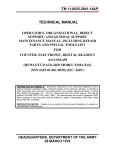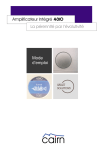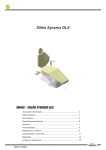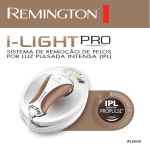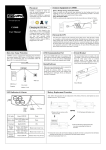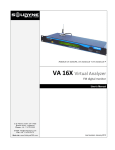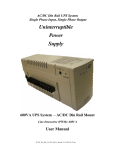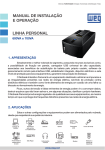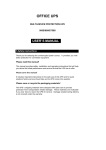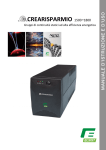Download User Guide - Opti-UPS
Transcript
For your records User Guide The serial number of your UPS is on the rear panel. You should note the serial number in the space provided below. Retain this booklet as a permanent record of your purchase to aid in identification in the event of theft or loss. Model No: Serial No.: Purchase Date: Clever Series Model CS385B, CS530B, CS730B LIMITED WARRANTY What the warranty covers: Limitation of implied warranties: THERE ARE NO WARRANTIES, EXPRESS OR IMPLIED, WHICH EXTEND BEYOND THE DESCRIPTION CONTAINED HEREIN We warrant this product to be free from defects in material and INCLUDING THE IMPLIED WARRANTY OF MERCHANTABILITY AND workmanship during the warranty period. If a product proves to be FITNESS FOR A PARTICULAR PURPOSE. defective in material or workmanship during the warranty period, we will at our sole option repair or replace the product with a like product. How long the warranty is effective: For accurate warranty period and conditions, please contact local branch offices or your dealers. Exclusion of damages: OUR LIABILITY IS LIMITED TO THE COST OF REPAIR OR REPLACEMENT OF THE PRODUCT. WE SHALL NOT BE LIABLE FOR: 1. DAMAGE TO OTHER PROPERTY CAUSED BY ANY DEFECTS IN THE PRODUCT*, DAMAGES BASED UPON INCONVENIENCE, LOSS OF Who the warranty protects: USE OF THE PRODUCT, LOSS OF TIME, LOSS OF PROFITS, LOSS OF This warranty is valid only for the first consumer purchaser. BUSINESS OPPORTUNITY, LOSS OF GOODWILL, LOSS OF DATA, LOSS OF SOFTWARE, COSTS OF SUBSTITUTE EQUIPMENT, What the warranty does not cover: INTERFERENCE WITH BUSINESS RELATIONSHIPS, CLAIMS BY THIRD 1. 2. 3. Any product on which the serial number has been defaced, modified or removed. Damage, deterioration or malfunction resulting from: a) Accident, misuse, neglect, fire, water, or other acts of nature, unauthorized product modification, or failure to follow instructions supplied with the product. b) Repair or attempted repair by anyone not authorized by OPTI. c) The fault is the result of accidental damage or damage in transit or transportation, including but not limited to liquid spillage. d) Removal or installation of the product. e) Causes external to the product. f) Use of supplies or parts not meeting our specifications. g) Normal wear and tear. h) Any other cause which does not relate to a product defect. Removal, installation and set-up service charges. PARTIES, OR OTHER COMMERCIAL LOSS, EVEN IF ADVISED OF THE POSSIBILITY OF SUCH DAMAGES. 2. ANY OTHER DAMAGES, WHETHER INCIDENTAL, CONSEQUENTIAL OR OTHERWISE. 3. ANY CLAIM AGAINST THE CUSTOMER BY ANY OTHER PARTY. Effect of state law (for US): This warranty gives you specific legal rights, and you may also have other rights which vary from state to state. Some states do not allow limitations on implied warranties and/or do not allow the exclusion of incidental or consequential damages, so the above limitations and exclusions may not apply to you. Life Support: We do not recommend the use of our UPS products for life support IMPORTANT SAFETY INSTRUCTIONS IMPORTANT SAFETY INSTRUCTIONS SAVE THESE INSTRUCTIONS equipment or direct care where failure of a UPS product could cause failure of, or diminished effectiveness of the life support equipment or patient care. *Except as expressly provided for by the UPS “Equipment Protection Policy” ● EFFECTIVE October 1, 1997 ● ● ● ● ● ● ● ● WARNING (SAVE THESE INSTRUCTIONS): This manual contains important instructions that should be followed during installation and maintenance of the UPS and batteries. WARNING (Controlled Environment): These units are intended for installation in a temperature controlled, indoor area free of conductive environment. CAUTION: Risk of electric shock, do not remove cover. No user serviceable parts inside. Refer servicing to qualified service personnel. CAUTION: Do not dispose of batteries in a fire, the battery may explode. CAUTION: Do not open or mutilate the battery, released electrolyte is harmful to the skin and eyes. It may be toxic. CAUTION: A battery can present a risk of electric shock and high short circuit current. The following precaution should be observed when working on batteries: Remove watches, rings or other metal objects. Use tools with insulated handles. Wear rubber gloves and boots. Do not lay tools or metal parts on top of batteries. Disconnect charging source prior to connecting or disconnecting battery terminals. Servicing of batteries should be performed or supervised by personnel knowledgeable of batteries and the required precautions. Keep unauthorized personnel away from batteries. When replacing battery, replace with same type. Do not connect any additional batteries by yourself. -1- 1.1 “Power On” Indicator TABLE OF CONTENTS Important Safety Instructions ................................................................................... 1 1. Presentation .......................................................................................................... 2 Power On indicator illuminates when utilities’ power is normal. The indicator also illuminates per each 4 seconds under Backup mode. Rapid flash (1 sec) means the inner battery should be replaced again. Attention: The internal battery has to be replaced when rapid flash occurred under AC mode. 2. Installation............................................................................................................ 3 3. Operation.............................................................................................................. 4 4. Software and Computer Interface (Option) .......................................................... 5 5. Battery Maintenance and Replacement ................................................................ 6 Appendix A Troubleshooting.................................................................................... 6 Appendix B Specifications ....................................................................................... 7 1.2 Outlets Design for AC Adapters Allow two AC power adapter blocks to be plugged into the UPS without blocking adjacent outlets. 1.3 Battery Power-Supplied Outlets Please read and save this manual! Thank you for selecting this uninterruptible power system (UPS). It provides you with a perfect protection for connected equipment. The manual is a guide to install and use the UPS. It includes important safety instructions for operation and correct installation of the UPS. If you should have any problems with the UPS, please refer to this manual before calling customer service. Inspect the UPS upon receipt. The packaging is recyclable; keep it for reuse or disposed of properly. Provide instantaneous back-up power and full-time bypass protection to your equipment. Ensure temporary uninterrupted operation of your equipment during power failure. 1.4 Full-time Bypass Protection Outlets Provide full-time Bypass protection to your equipment. Prevent surge from traveling through your system through unprotected peripherals. 1.5 Power button (ON/OFF/TEST/SILENCE) The UPS can be turned on while pressing power button until buzzer stops (about 2 seconds). After the UPS is turned on, it conducts a self-test and enter normal mode. Press the power button for 1 second under normal mode would also enable the self-test function again. The silence function can be enabled/disabled by pressing the power button for 1 second under backup mode. In addition, Power button can be used as the master on/off switch of your equipment by leaving your equipment connected to UPS and switched on. To turn off the UPS, please press power button until buzzer stops (about 2 seconds). 1. PRESENTATION Front View and Side View 1.6 Circuit Breaker (or Fuse) Serves as an overload and fault protection. This is a critical component of the advanced UPS surge protection circuit. Circuit Breaker Circuit Breaker Switch Switch 2. INSTALLATION 2.1 Recharge the battery 385 VA 530/730 VA The styles of cover are just for reference only -2- UPS may be used by anyone immediately upon receipt. The battery is fully charged before shipped from the factory. However, user is recommended to recharge the battery at least four hours before using UPS. Energy loss may occur during shipping or long duration storage. To recharge the battery, simply let UPS be plugged into an AC outlet and switch it on. 2.2 Connect the loads Plug your primary equipment (e.g. computer, monitor and critical data storage device, -3- etc.) to the Battery backup outlets. Plug your peripheral equipment (e.g. printer, scanner, fax, or audio device) to the Full-time Bypass Protection outlets. Do not plug laser printer to the UPS, as its power demand is much higher than typical peripherals and may cause the circuit breaker (or fuse) to trip. 3.2 Check the power requirement of your equipment If you wish to protect a fax or a modem, connect the telephone cable from the wall outlet to the “IN” jack. Connect the telephone cable (provided) from the “OUT” jack to the fax or modem. To protect a10/100Base-T (UTP) network interface, obtain and use a UTP cable to connect the “OUT” jack to your computer. 3.2.1. Make sure the total power of your equipment does not exceed rating capacity. 3.2.2. Also make sure the equipment you plugged into the Battery Power-Supplied outlets does not require total power exceeding the capacity of the UPS. Otherwise, overload may occur and cause the circuit breaker to trip. If the power requirement of your equipment differs from VA, convert the requirement power into VA by doing the calculations below: 3.2.3. If the power requirement of your equipment is listed other than VA, convert the requirement into VA by doing the calculations below. Watt (W) X 2 = VA 2.4 Connect to the utility power 3.3 Limited rating power of UPS Plug UPS to a 2-pole, 3-wire grounding receptacle. Make sure the battery supply outlets of the UPS do not service equipment requiring heavy electricity (e.g. refrigerator, air conditioner, copier, etc.) Attention: When using extension cords, make sure the total rating of the loads is suitable. When utility power failure occurs, the battery power outlets will supply power to your equipment from its battery. The buzzer will beep once every 4 seconds. Be sure that your equipment is running under the limited rating power. To restore the battery power by plugging UPS back in to the existing power source. Perform the self-test to make sure UPS works properly. 2.3 Connect the telephone 3.4 Checking table for Buzzer, LED and Status. 2.5 UPS self-test UPS will conduct a self-test once switched on it each time. Besides this, switch on your equipment after switch on UPS. This function is disabled while buzzer is alarmed caused by full (over) loads. Buzzer OFF OFF 2.6 Battery auto-charging The internal battery would be charged by charging circuit automatically, while utility power is connected to the unit. 2.7 Auto restart feature UPS would shut-down while battery voltage is too low, and wake up automatically when utility power and battery voltage is normal. 2.8 Overload protection UPS automatic shut down if load exceeds 110% of nominal rating for 10 sec or if load exceeds 120% of nominal rating for 3 sec. 2.9 Optimal battery status ON ON:4’S OFF:1’S ON:1’S OFF:4’S ON:1’S OFF:1’S ON:0.5’S OFF:0.5’S Power-on LED (GREEN) ON ON:0.5’S OFF:0.5’S AC MODE ON BACKUP MODE ON:1’S OFF:4’S AC MODE ON BACKUP MODE ON:1’S OFF:4’S ON:1’S OFF:4’S ON:1’S OFF:1’S ON Status AC MODE BATTERY FAULT OVER LOAD FULL LOAD BACKUP MODE BATTERY LOW CHARGER ABNORMAL To maintain the optimal battery status, leave UPS plugged in and switched on at all time. 4. SOFTWARE AND COMPUTER INTERFACE 2.10 No load Shutdown feature UPS is equipped with no load shutdown function. While no loads are connected to the UPS, the unit will automatically shutdown after 3 minutes. 3. OPERATION 3.1 Simple test It is recommended that the user perform a simulation test when using UPS for the first time or when adding an additional piece of equipment. Conduct a simulation-test: first, switch on UPS and wait for the power indicator to light up, then simply unplug UPS to simulate the event of utility failure. -4- 4.1 Power Monitoring Software The OPTI-SAFE Sentinel software (or other power monitoring software) is applied standard USB interface to perform monitoring functions, and then provides an orderly shutdown of a computer in the event of power failure. Moreover, OPTI-SAFE Sentinel displays all the diagnostic symptoms on monitor, such as Voltage, Frequency, Battery level and so on. The software is available for Windows 95/98/2000/Me, Windows NT V4.0 or later, Novell Netware and others. Call your dealer for more information on computer OS compatible solutions. -5- 4.2 Interface Kits A series of interface kits is available for operation systems that provide UPS monitoring. Each interface kit includes the special interface cable required to convert status signals from the UPS into signals which individual operating system recognize. The interface cable at UPS side must be connected to REMOTE PORT, at computer side can be either COM 1 or COM 2. The other installation instructions and powerful features please refer to READ.ME file. APPENDIX B SPECIFICATIONS MODEL UPS Capacity(VA/W) No. of sockets (NEMA 5-15R) CAUTION: Use only factory supplied or authorized UPS monitoring cable! 4.3 The characteristics of computer interface port The computer interface port has the following characteristics: The communication port on the back of the UPS may be connected to host computer. This port allows the computer to monitor the status of the UPS and control the operation of the UPS in some cases. Its major functions normally include some or all of the following: To broadcast a warning when power fails. To close any open file before the battery is exhausted. To turn-off the UPS. Some computers are equipped with a special connector to link with the communication port. In addition, special plug-in cord may be needed. Some computers may need special UPS monitoring software. Contact your dealer for the details on the various interface Kits. Output Voltage (on battery) 730VA/365W 2 Battery 2 Battery Backup + Backup 2 Surge Protection Simulated sine wave at 100V/115V/ 220V/ 240V +/-5% AVR Controlled by PWM Protection Frequency 50 or 60Hz +/- 10% (auto sensing) Unit Input Circuit breaker for overload & short circuit protection Overload Protection Type Battery 50 or 60Hz +/- 0.3Hz 100V +/-20%, 110V +/- 25%, 220V/230V/240V, 170V~280 at line input UPS automatic shutdown if overload exceeds 110% of nominal at 10 seconds, 120% at 3 seconds UPS output cut off immediately 460 Joules(MAX.), 2ms Sealed, maintenance-free lead acid batteries with 3-5 years typical lifetime Typical Recharge Time (to 90% of full capacity) To store UPS, cover it and store it with the battery fully charged. During extended storage, just connect the utility power to recharge the battery every three months to ensure battery life. Protection APPENDIX A TROUBLESHOOTING Weight (Net) -6- 530VA/265W Voltage (single phase) Input Spike Protection Possible Cause Solution Circuit breaker button popped up as Unplug at least one piece of equipment a result of overload. from the Full-time Surge Protection outlets. Switch off UPS, wait 5 seconds, reset the circuit breaker (press down breaker button), then switch on UPS. UPS doesn’t Battery undercharged or depleted Recharge the battery by leaving the UPS perform to its due to frequent power outages. plugged in and switched on. expected runtime. The power required by your Unplug at least one piece of equipment from the UPS outlets. equipment slightly exceeds the capacity of the UPS. The battery is slightly worn-out. Consider replacing the battery. UPS cannot be The battery is worn-out. Replace the battery the instructions in this turned on. manual. Mechanical problem. Contact your sales representative. 385VA/190W <10 milliseconds, including detection time 5.1 Battery maintenance Problems Full-time Bypass Protection outlets stop providing power to the equipment CS730B Transfer Time Short Circuit 5.2 Storage CS530B Frequency (on battery) 5. BATTERY MAINTENANCE For the preventive maintenance, keep the area around the UPS clean and duty-free. Please also keep the UPS at ambient temperature of 25℃ (77℉). It is recommend that the batteries charge for 24 hours after long storage. CS385B Physical 6 hours Automatic itself-test, Over discharge protection, short circuit protection by fuse 3.53 lbs 5.73 lbs 1.6 kgs 2.6 kgs 3.74×3.74×6.22 Dimensions (L×W×H) inches 95×95×158 mm Interface Communication Port Battery Back-Up Alarm 3.74 × 5.43 × 6.22 inches 95 × 138 ×158 mm USB port Slow beeping sound every 4 seconds (Buzzer can be muted by pressing main switch button) Battery Low Continue beeping sound every second 100% load Continue beeping sound every 4 second Overload Continue beeping sound Ambient operation Environment 3,500 meters max. elevation, 0-95% humidity (non-condensing water), 0-40℃ Audible Noise <40dBA (1 meter from surface) -7-







